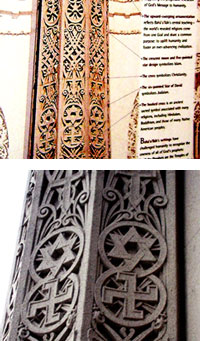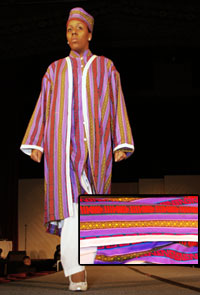Universal Symbol of the Swastika and its Original Use and Meaning by Ancient Cultures of the World
More colmuns by Mother Tynnetta Muhammad

“And we created not the heaven and the earth and what is between them for sport. Had We wished to take a pastime, We would have taken it from before Ourselves; by no means would We do (so). Nay, We hurl the Truth against falsehood, so it knocks out its brains, and lo! it vanishes. And woe to you for what you describe!” —Holy Qur’an, Surah 21, verses 16-18
The original symbol of the swastika or hooked cross was never used with anti-Semitic or Neo-Nazi meaning, but later it was subverted into its use as a symbol of evil and wicked purposes under the banner of Hitler and the rise of the National Socialists German Party. The swastika since that time has been associated with fascism, racism, World War II and the holocaust in much of the Western World.

The swastiska has not always been used as a symbol of Nazism and was, in fact, borrowed from Eastern cultures. It seems to have been used by early inhabitants of Eurasia. It is an important symbol in Eastern religions, notably Hinduism and Buddhism, among others, and was also used in Native American faiths before World War II.
It was known worldwide as a symbol of good luck and auspiciousness, even this symbol appeared on the spines books by the Anglo-Indian writer, Rudyard Kipling, and the symbol was used by Robert Baden-Powell’s Boy Scout movement. In searching the internet on the history of the swastika, Jennifer Rosenberg writes that “The swastika is an extremely powerful symbol. The Nazis used it to murder millions of people, but for centuries it had positive meanings.”
The word “swastika” comes from the Sanskrit Svastika-“Su” meaning good, “Asti” meaning “to be,” and “ka” as a suffix. Until the Nazis used this symbol, the swastika was used by many cultures throughout the past 3,000 years to represent life, sun, power, strength and good luck.” She further states, “In 1920, Adolf Hitler decided that the Nazi Party needed its own insignia and flag. For Hitler, the new flag had to be a symbol of our own struggle,” as well as “highly effective as a poster.” (Mein Kampf, pg. 495)
On August 7, 1920, at the Salzberg Congress this flag became the official emblem of the Nazi Party.
In 1974, the Honorable Elijah Muhammad was guided by the Master to make a move to our neighboring country of Mexico and announced to his Laborers and family members that he was travelling outside of the country with his wife to take care of very important business. Thus, I was placed there with our young family in our present residence. Among the many assignments that he shared with me was to study the world’s calendars and their prophetic histories. At that time I was unaware that the Mayan calendar was known worldwide as being more accurate in its calculations of time and historical cycles than the Western Gregorian calendar designed by Pope Gregory XIII.
I have been blessed by the Honorable Elijah Muhammad to come into further knowledge of his works and teachings that expand the universe. Within three months of his departure in February 1975, I began my travels abroad which began in Egypt and extended to the holy cities of Medina, Mecca and Jerusalem. My travels continued into a few countries in Europe and other parts of the Middle East. These travels have continued under the spiritual guidance of the Honorable Minister Louis Farrakhan which has taken me to many more countries in the Caribbean, Africa, Asia, to the Islands of the Pacific, to Australia and New Zealand in constant search for knowledge that corroborates the Divine Teachings of the Honorable Elijah Muhammad. Never would I have imagined before my present experience that I would visit such far away and remote places such as Russia, Siberia and Mongolia.
When I was awarded the diploma written in the Mongolian language bearing many significant symbols pertaining to the history of Genghis Khaan and the Mongolia Nation, I was intrigued by this particular symbols of the hooked cross appearing on one of the standards of Genghis Khaan. When I returned to the United States and displayed this award to the Honorable Minister Louis Farrakhan, he brought to my attention the use of the swastika symbol or hooked cross that was placed on one side of the diploma. He was concerned by what others might interpret it to mean in the secular world of Western politics and history. He was aware that it had an ancient, universal meaning for many ancient cultures. He spoke about having seen this symbol on a visit to the Baha’i Temple and Center in Wilmette, Illinois, outside of Evanston.

As has already been pointed out, the use of the swastika or hooked cross, goes into thousands of years and is considered sacred to Native American cultures, in Africa, Asia and in Europe and has no connection whatsoever with the meaning that is incorporated into Nazi, Germany, and anti-Semitism.
I quote again from internet information taken from Crystalinks the following information, “Following his discovery of objects bearing the swastika in the ruins of Troy, Heinrich Schliemann consulted with leading Sanskrit Scholars of the day Emile Burnouf and Max Muller. Schliemann concluded that the swastika was a specifically Aryan symbol. This idea was taken up by many other writers and the swastika quickly became popular in the West, appearing in many designs from the 1880s, to the 1920s. The positive meanings of the symbol were subverted in the early 20th Century when it was adopted as the emblem of the National Socialist German Workers Party.
“This association occurred because Nazism stated that the historical Aryans were the modern Germans and then proposed that because of this, the subjugation of the world by Germany was desirable and even predestined. The swastika was used as a convenient symbol to emphasize this mythical Aryan-German correspondence. Since World War II most Westerners see the swastika as solely a Nazi symbol leading to incorrect assumptions about its pre-Nazi use and confusion about its current use in other cultures.”
The dress design woven into my Al-Tai Collection as featured in the above photo shows an insert focusing on one of the patterns that is interwoven and manufactured in the country of Mexico. This motif woven into their fabric designs called Cambay. It is an example of how fretwork patterns have an ancient origin in Native societies but was never used with a degrading or negative meaning.
“And to Him belongs whoever is in the heavens and the earth. And those who are with Him are not too proud to serve Him, nor are they weary. They glorify (Him) night and day: they flag not. Or have they taken gods from the earth who give life? If there were in them gods besides Allah, they would both have been in disorder. So glory be to Allah, the Lord of the Throne, being above what they describe.” —Holy Qur’an, Surah 21, verses 19-22
To be continued.












